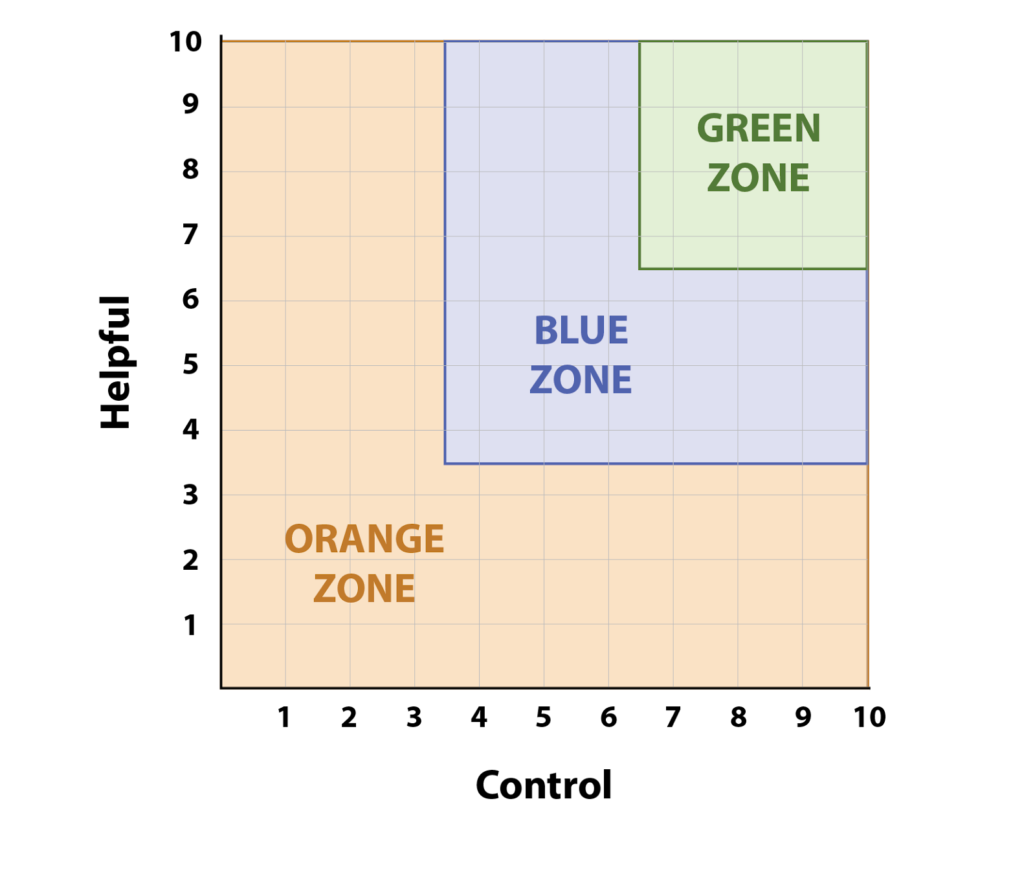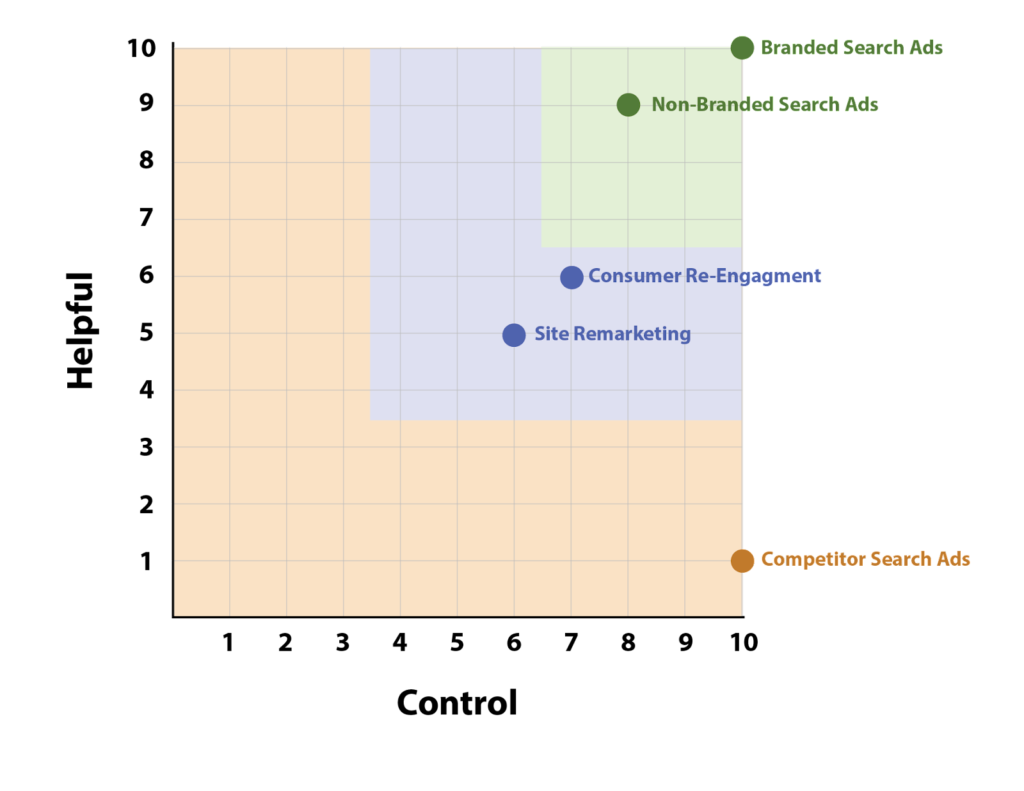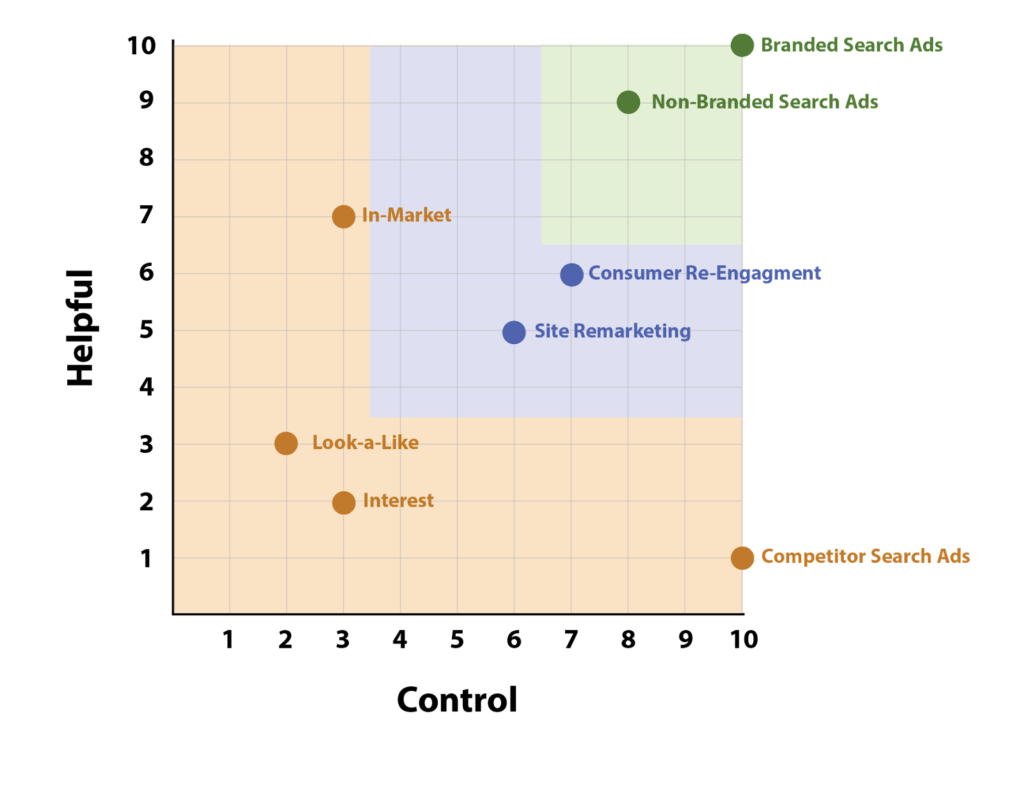Are Search & Display Ads Evil?
In the year 2023, we have all experienced ad overload from a company. That’s right, you viewed a product one time on Nike’s website, now, every time you open up Facebook, BOOM Nike ad. Okay open up Instagram, BOOM an in-feed Nike ad. Surely there won’t be a Nike ad while reading your local morning news website. Wrong. There, on the side, is a Nike banner ad. These ads even find their way onto your solitaire app.
While some people do actually find these ads helpful, others of us feel like we are being bombarded or even stalked by these companies. Why are they showing up everywhere? Are they invasive or helpful?
So, is ALL paid advertising Evil?
Truthfully our answer is no, paid advertising isn’t usually evil and in fact can be used for a lot of good. And yes this is coming from someone who makes a living running these ads but bear with us here.
We understand that companies have their own view on paid advertising. Some love it and will pour all their money into running +50 campaigns and other companies fear that paid advertising comes off as sleazy and inauthentic to consumers.
But with paid advertising there are so many forms of targeting and placements, that labeling them all the same way isn’t the best route. We have created an Authenticity scale that uses two metrics, control and helpfulness. The Goal of the Authenticity scale is to help advertisers determine what their comfort zone is when it comes to paid advertising.
First we are going to do a brief recap of search ads and display ads. Next we will outline what the Authenticity Scale is and how to use it. Finally, we will break down a handful of examples and place them on the scale to help you get the hang of it.
SEARCH vs. DISPLAY ADS
Let’s quickly layout 2 kinds of Google ads, search and display ads, before we dive into the Authenticity of advertising tactics.
- First, Search ads. Search Ads appear alongside organic results when a consumer enters a query in the search engine. Advertisers bid on search terms and if those terms are queried then their ad may appear. For example, if Nike bid on “Running shoes” and someone searches “Best tennis shoes for running” then they will be met with a Nike ad like the one below:
- Display ads. Display ads can appear in apps, in video, or as banner ads on websites. They will look something like this:

Now that we have nailed down two ad types, let’s jump into our Authenticity Scale.
ADVERTISING AUTHENTICITY SCALE
Paid advertising comes in many forms. In order to determine an ad’s Authenticity, we are going to utilize two different scales.
- Control: The control an advertiser has over who, where, how a consumer is receiving ads.
- Helpfulness: The extent to which an ad is helpful to the consumer.
When using this two point scale ads are going to fall into a Green Zone, Blue Zone, and Orange Zone.
Ads that are high on both control and helpfulness are going to be in the Green Zone. The Green Zone consists of ads that will almost always be beneficial for both company and consumer.
Next are our Blue Zone ads, which are ads that will be in the middle of either control or helpfulness. These ads are usually still beneficial for company and consumer, though seeing as they fall in the middle of one or both of the scales we can’t be certain about either customers intent or placement of ads.
Now for our Orange Zone ads. Orange Zone ads will fall low on one or both of the scales. Just because ads are in the Orange Zone doesn’t mean they are evil, however, we understand there is a time and a place for them. We recommend using Orange Zone ads when the primary focus is for brand awareness rather than high conversion rates.
Let’s look at this on a graph.
Advertising Authenticity Score

PUTTING THE GRAPH TO WORK
Now let’s put this graph to work and plot where different advertising strategies fall.
SEARCH ADS IN THE ORANGE ZONE:
I am going to play devil’s advocate right off the bat, and give an example of advertising that is closer to the ~evil~ side, or inauthentic side, of advertising.
Competitor Search ads. For a company like Nike, this would be bidding on terms like “Adidas Shoes”. On our first scale, Control, competitor search ads actually rank very high. We would know where these ads are showing and for the exact search terms they are showing for.
On our second scale, Helpfulness, Competitors Search ads rank very low placing them in the Orange Zone. If a consumer searches, Adidas shoes, chances are they know what they want and it’s not Nike Shoes. With this method of advertising, the goal is less about being helpful and more about disrupting a consumer’s actions. Getting Nike’s name in their last minute, one, probably won’t have a high return on investment, and two, is disregarding the consumers preferences and is thus more invasive.
Therefore, Competitor Search ads are in our bottom right corner in the Orange Zone.
Advertising Authenticity Score

SEARCH ADS IN THE GREEN ZONE:
Now let’s look at Search ads that are on the flip side of the Helpful scale in our Green Zone.
Branded Search Ads. Pretty self explanatory, but Branded Search ads re when a company bids on its own name. For example Nike bidding on “Nike” or “Nike Shoes”.
- Control: These ads like Competitor Search ads rank high on control. When bidding on branded terms you have a narrow and controlled pool of search terms your ads are showing up for.
- Helpfulness: Unlike Competitor Search ads, Branded Search ads are high on Helpfulness. When a consumer is searching for your company, they are point blank looking for you and exactly you. Therefore you want to be front and center for them when they search.
Non-Brand Search Ads. Some examples of Non-Brand Search keywords for Nike are “Athletic shoes”, “gym shoes”, or “best sneakers for running”.
- Control:In terms of control Non Brand Search ads rank just below Branded Search Ads. The only reason there is a little less control is because there is a wider pool of search terms.
- Helpfulness: Believe it or not, non brand search ads we still classify as high on the helpfulness scale. If a consumer is searching for a product and just doesn’t know the name of a company that supplies said product they are still information gathering.
Let’s go back to Nike but pretend that this consumer who is searching for running shoes does not know any of the big brands. The consumer searches for “running shoes”. They are looking for a high quality product, so why not Nike. Whether Nike is bidding on these terms or not other people will be. Therefore, even if Nike is the first organic result, they won’t be the first company that consumers see because there will be ads at the top. If Nike is the best option for the consumer and they simply don’t see them because their organic result is buried under ads then both consumer and company are missing out. Thus you want to be there as an option in their search for information.
Since both our Brand and Non-Brand Search ads ranked high on Control and Helpfulness, that places them right in our Green zone.
Advertising Authenticity Score

DISPLAY ADS IN THE BLUE ZONE
Let’s dive into which Google Display ads fall into our Blue Zone.
Consumer Renegament Display ads: targeting previous consumers based on email lists. This is not people who have simply visited the site but people who have actually purchased the product or service.
- Control: Medium High. Since this ad type is based on email lists from the company we know exactly who we are targeting. The only reason it is bumped down a few points is because of the nature of display ads. In this scenario we aren’t picking specific placements on the google display network so the ads could be running on a variety of sites and apps.
- Helpfulness: Medium. Truthfully this one depends on the product being sold. For instance if the product being sold is a Refrigerator, consumers probably aren’t going to be in the market for a new refrigerator for many more years. Therefore hitting them with a display ad 3 months after purchase isn’t helpful.ing.
However if the product being sold is a face wash, hitting the consumer with an ad 3 months after initial purchase to remind them to place a new order before they run out can be very helpful. We know these people have used the company’s product or service, and assuming a positive experience, they most likely like the company and would purchase again.
Site Remarketing Display Ads: targeting those who have visited the companies site without purchase.
- Control: Medium. We know for the most part who is being hit with the ads but it’s a wider pool than consumer re-engagement and it’s on the Display network.
- Helpfulness: Medium. Hopefully the consumer is at least interested in the company, hence spending time on the site. However we don’t fully know their motives for being on the site or their impressions of the company after the visit.
Blue Zone ads tend to be reconnecting with people who are at least aware of the company’s name.
Advertising Authenticity Score

DISPLAY ADS IN THE ORANGE ZONE
We talked about Competitor Search ads being in the Orange Zone but let’s finish filling this zone out.
In Market Display: Using Google’s AI, we are targeting those who are in the market for a product. For example Nike’s In Market Display ads would be targeted at people who are “in the market” or looking to purchase running shoes. Again, who is in the market for new running shoes is determined by google not the advertiser.
- Control: Low. The nature of display ads already knocks it down a few pegs, but the second reason it loses points is because we are relying on google’s targeting metrics. What exactly makes someone “in market” for new running shoes? We as advertisers have less control over who sees the ads when google is at the wheel.
- Helpfulness: Medium high. Since we are targeting people who are in-market or actively looking for a new pair of running shoes, showing Nike’s name is hopefully beneficial.
Interest Display Ads: Using Google’s AI to target people who have interests that would align with a company’s target market. Using Nike again as an example, they could target people with interests in playing sports, running marathons, or even coaching.
- Control: Medium low. We have an idea of who is getting targeted but again it’s a very wide pool that google has created. Also, as stated before, the display network naturally has less control than search ads.
- Helpfulness: Low. Honestly with this group we truly don’t know if they are interested in running shoes at the moment, they might be swimmers or love their new balances. The positives for running ads like this would be more for brand recognition. Getting your company’s name out there so that they are remembered when the consumer is looking for your product even if they aren’t in need of it at the moment.
Look Alike Display Ads: Target people who match a profile (lookalike) of those who have purchased a product or used your service. Lookalikes are again determined by google’s AI.
- Control: Low. Again, this is reliant on what google demes a lookalike. Maybe Because we don’t know what metrics google uses to compare, we deem these pretty low on control.
- Helpfulness: Medium low. Going on the idea that google is in fact showing us to quality consumers we rank this medium low. Ideally they will be similar to previous consumers but that’s not to say they are in the market for your service right now.
As we state early, just because an ad is in the Orange Zone doesn’t mean it is evil and invasive by nature. For our Green and Blue Zones we are looking for conversions and a lower cost./conversion. For these Orange Zones ads on the other hand it’s best to have a totally different goal. That goal being brand awareness. Many of these ad types tend to have high impressions which is a great metric to use when trying to measure the success of a brand awareness campaign.
Advertising Authenticity Score

WRAPPING UP
We went over a lot of ad types and tactics today and, let’s be honest, that’s just breaking the surface, since we didn’t even touch on Social media advertising. With all the different kinds of targeting and placements out there, it can get overwhelming for a company to decide what direction they want to take and what kind of advertising aligns with the values of their company. By looking at each tactic individually and using this two point scale companies can better understand if said tactic fits within their comfort zone.
Now what about our very first example of one person getting bombarded with every ad on every network for Nike Tennis Shoes? Yeah….we would consider this the closest thing to invasive evil advertising. Though we would also be lying if we said these ads have never worked on us.

Leave a Reply